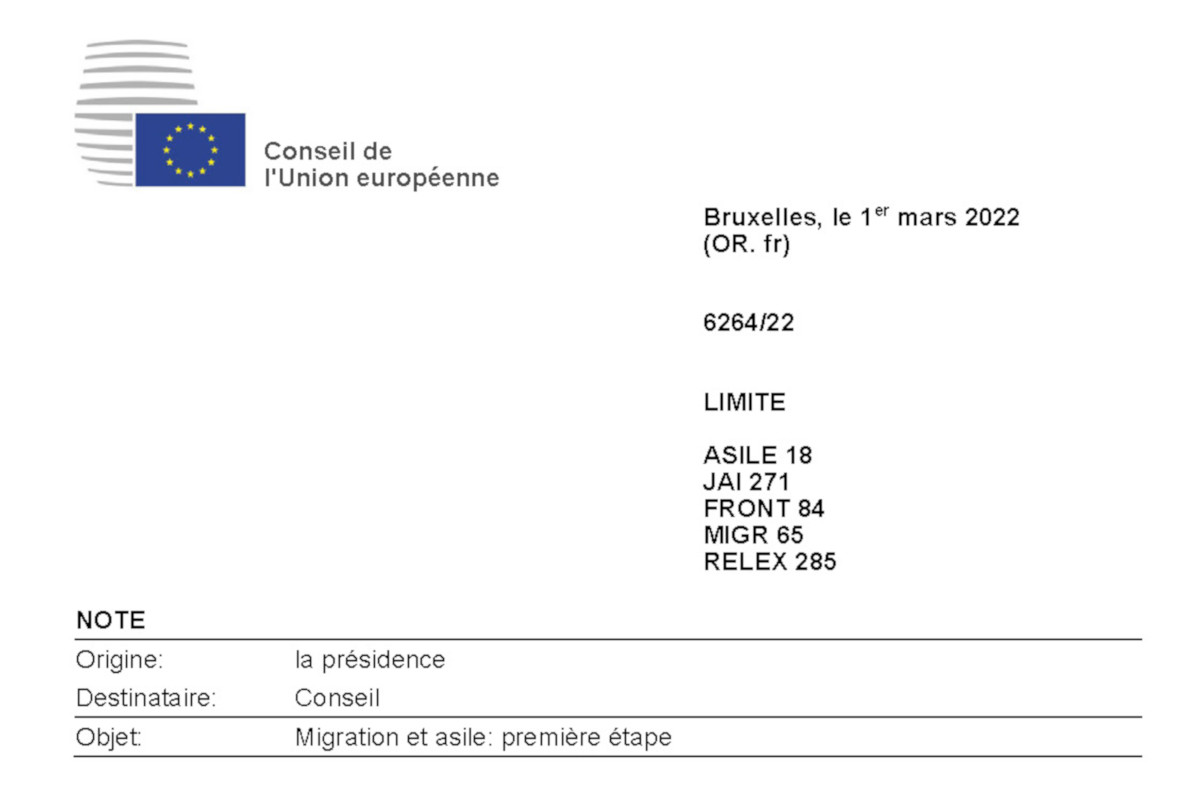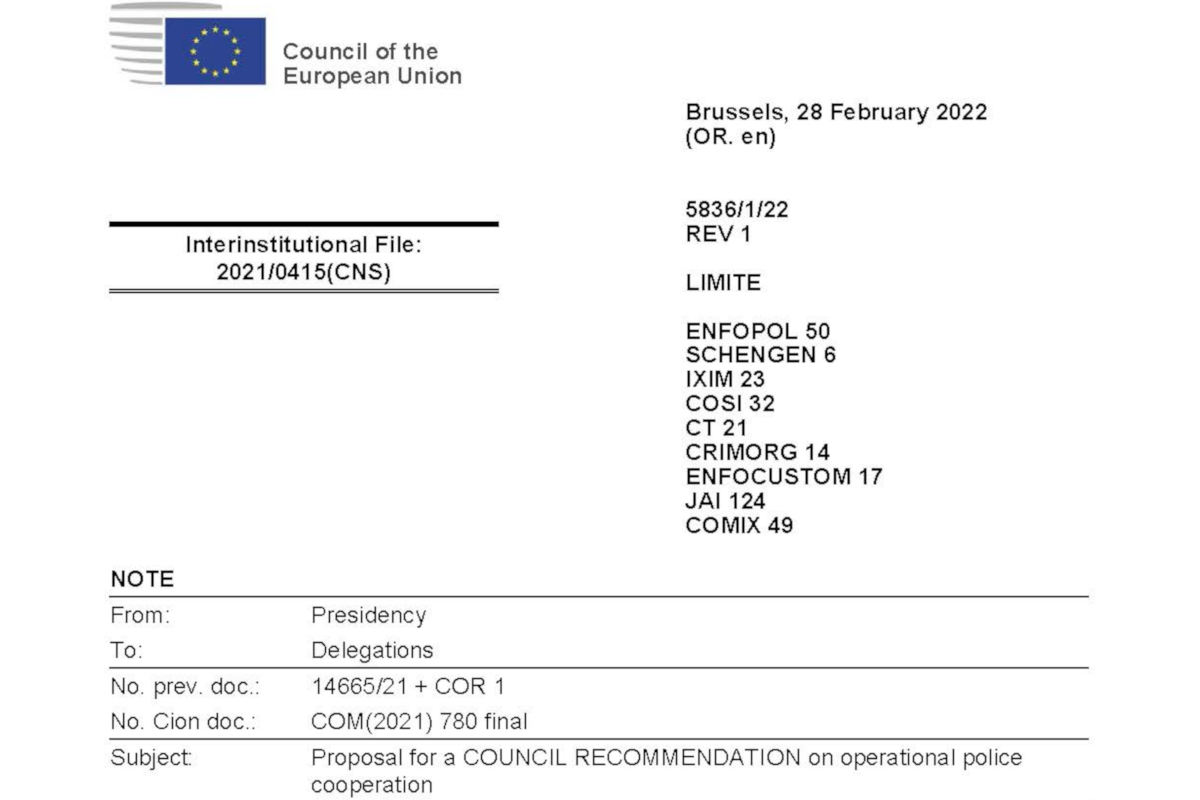EU: Tracking the Pact: Externalisation and “Team Europe” at the heart of the “gradual approach”
Topic
Country/Region
25 March 2022
With negotiations on the laws that make up the EU’s Pact on Migration and Asylum making little progress, in January the French Presidency of the Council proposed a “gradual approach” – pickling out some elements on which progress could be made, and leaving others to one side. Key to the plans is the consolidation of political unity amongst member states and EU institutions (“Team Europe”) in order to further externalise migration control.
Support our work: become a Friend of Statewatch from as little as £1/€1 per month.

At the beginning of March, after discussions in COREPER (the Committee of Permanent Representatives) and an informal meeting of interior ministers in Lille, the Presidency circulated a document (pdf) identifying six focus areas:
- operationalising the external dimension;
- controls and registration at the external borders;
- progress on returns;
- providing financial, human and material support to member states with external borders;
- establishing a compulsory “solidarity” mechanism, whether it concerns the relocation of asylum applicants from one member state to another or alternative solidarity contributions;
- improving implementation of the ‘Dublin III Regulation’ and working to limit and prevent so-called “secondary movements”.
The introduction also refers to the Russian invasion of Ukraine and the ensuing displacement of people towards the EU, in the context of which “Europe is honouring its duty to welcome people fleeing war,” an issue to be discussed at an extraordinary Justice and Home Affairs Council meeting soon. The Presidency asserts that the crisis confirms that border protection and solidarity between member states must be reinforced, a goal towards which the first phase of the “gradual approach” should contribute.
A key theme that emerges from the document is its emphasis on consolidating political unity among member states and EU institutions (the so-called “Team Europe” approach) in their efforts to compel third countries to adopt migration policies compatible with the EU’s own migration policy goals. The nature of this project raises serious fundamental rights concerns, as do the means for its implementation: the secretive MOCADEM mechanism; an overarching priority to increase returns regardless of the economic and ethical cost; and a redefinition of solidarity as helping member states to process and deport people.
Operationalising the external dimension
This priority theme in the Pact on Migration and Asylum makes it clear that coercion is a feature of externalisation, despite it being presented as a cooperative effort. “Existing levers” should be used in a “coordinated and coherent” manner by member states and the EU, says the document, requiring teamwork in their relations with third countries.
At least two action files have been adopted so far through new MOCADEM framework, on Iraq and Niger, with the possibility of restricting Schengen visa issuance if they do not cooperate with readmissions high on the agenda.
Strengthening Frontex’s role in support of member states in the field of international cooperation entails developing its role in returns from EU countries, border management and capacity building to prevent “illegal immigration”. To do this, the Commission and Council are tasked with identifying countries with which to negotiate status or working agreements. EU support for priority countries of origin and transit (particularly in north and sub-Saharan Africa) is envisaged to prevent “migration flows”, for which “Team Europe initiatives” will soon be launched, with funding available through NDICI.
One sentence makes the overarching goal clear:
“The European Union must… intervene in support of the states of origin and transit to prevent migratory flows.”
Controls, registration and “discretion” at the external borders
The document calls on member states to set up uniform screening procedures, with controls and registration based on health, vulnerability, identity and security checks; Eurodac registration and rules on people’s legal status at external borders. Regarding screening at external borders, checks should include a preliminary health assessment, identification of vulnerable subjects, identity and security checks and registration in EURODAC.
This model will apply in cases involving unauthorised external border crossings, disembarkation after sea rescues and people who apply for international protection at border crossing points or in transit zones. Member states should enjoy discretion regarding the choice of locations, says the Presidency. In principle they should be or near external borders, if capacity to receive third-country nationals in such places is insufficient then the process may take place elsewhere.
People residing without authorisation in EU territory will also be subjected to screening if there is no evidence of a border crossing and they have been previously screened in another member state. There is no indication of what the consequences of this process may be for the individuals concerned.
Regarding people’s legal status at the border, they should be denied entry if they do not fulfil the requirements of the Schengen Borders Code, providing a legal basis for measures aimed at preventing absconding; and for returns using derogations available under Article 2(2) the Returns Directive, thus eluding its full application and allowing member states to fall back on national law. This legal status would be limited to five days, extendable to 10 at most if exceptional circumstances apply.
States should be granted discretion to adopt measures to ensure people remain at their disposal, and alternatives to detention must be adequate to enable control and prevent flight, says the document. Assignment to residence and mobility restrictions (in open or semi-open structures, with surveillance) are described as “preferable”.
For Eurodac registration, a category may be created for people who disembark after sea rescues in order providing clear data about such arrivals, and aiding in assessments of “pressure”. Data must be transferred to the central system within three days (five in cases involving “mass” influxes), and states should request support from the Asylum Agency or Frontex if necessary.
Progress on returns
Cooperation on readmission with priority third states is seen as key to stepping up the number of deportations. The European Commission’s Return Coordinator (a new high-level post that does not yet appeared to have been filled) should be supported by a “high level network” to encourage “cooperation with and among member states to manage return, readmission and reintegration processes”. This may include harmonising return policies and practices concerning consular cooperation and “practical solidarity” to support member states’ needs.
The Return Coordinator’s work should complement that of other actors in order to develop an operational strategy on returns, the document underlines. Meanwhile, efforts to continue work on reforming the Returns Directive (essentially to undermine human rights safeguards, seen as “obstacles” to removal) require the European Parliament to adopt a position on the legislation. “The Presidency could establish contacts with the European Parliament to discuss timing and content,” the document notes.
Support to frontline member states
The note recalls that home affairs funding worth more than €18 billion is available for the 2021-2027 period, with over 60% devoted to member state programmes that must be agreed with the Commission. An additional €11 billion are available for the EU’s justice and home affairs agencies, with Frontex due to get the lion’s share of the funds.
A permanent call to member states at external borders experiencing “strong migratory pressure” for projects to support their reception, asylum and returns systems was issued on 26 January, through which almost €189 million are available. The Presidency recalls that the “thematic fund” (the remaining slightly-less-than 40% of €18 billion) was used in response to the recent “migration crises” in Afghanistan and Belarus. The support available from EU agencies is also reasserted.
Compulsory solidarity mechanism
The document outlines a “solidarity mechanism” involving either the acceptance by member states of relocated individuals (e.g. such as people disembarked in Greece or Italy after being rescued at sea), or the provision of alternative solidarity contributions. Relocations to each state would be set by taking “quantifiable objective criteria” into account.
The Commission will play a “crucial role” in this mechanism, says the document, responsible for receiving requests for relocations from beneficiary member states; seeing that their needs are met; regularly monitoring relocations and the general situation, to guarantee that all relocations are enacted as swiftly as possible; and reporting back to the Council based on data provided by the new Asylum Agency to guarantee the mechanism’s transparency and effectiveness.
Non-participating member states will have to provide what are described as “substantial and proportionate alternative solidarity measures,” for example to cover reception costs through financial or other means such as staff or material resources. However, the Commission is to be responsible for verifying what is needed, and it may be that calls for “solidarity” from other member states are only made when EU means are insufficient. Once these more immediate needs are met, alternative contributions could be used to meet further goals like those arising from projects on the “external dimension”.
Improve implementation of the Dublin III regulation
The Presidency’s final point proposes adoption of a roadmap to improve implementation of the current Dublin regulation as restrictions linked to public health are withdrawn. The roadmap would require strengthened coordination by the Commission (alongside the Asylum Agency), including the use of administrative provisions envisaged by Article 36 of the Dublin III regulation that allow member states to establish “administrative arrangements” on a bilateral basis to implement this regulation.
Such arrangements would fall within the elements to consider in this first phase, and the scheduling for implementation could be “coherent” with the launch of the relocation mechanism. It would be useful for national practices regarding asylum and reception systems to “converge”, to promote the Asylum Agency’s work to direct countries in a way that enables member states to make its processes their own.
The Presidency closes the note by stating that the Commission will report on this first phase a year after its “dimensions” have come into force, followed by a debate within the Council.
Documentation
- NOTE from: Presidency to: Council: Migration et asile: première étape, Brussels, 1.3.2022, 6264/22, LIMITE, ASILE 18, JAI 271, FRONT 84 MIGR 65, RELEX 285.
Further reading
Our work is only possible with your support.
Become a Friend of Statewatch from as little as £1/€1 per month.
Spotted an error? If you've spotted a problem with this page, just click once to let us know.

